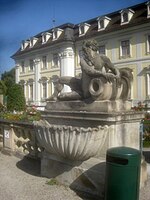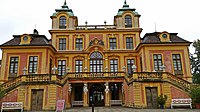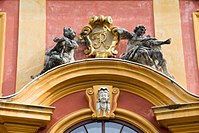Carlo Ferretti
Carlo Ferretti (born October 9, 1689 in Castiglione d'Intelvi , † after 1737 ) was an Italian sculptor and plasterer who mainly worked in Württemberg .
From 1712 or 1717 he worked as a sculptor at Ludwigsburg Palace and Favorite Palace, and from 1723 to 1726 as a plasterer in the Benedictine Abbey of Ottobeuren . In 1737 he was employed at Ansbach Castle . His most famous works are the stucco work for the imperial hall of the Ottobeuren monastery.
Life
Carlo Ferretti was born on October 9, 1689 in Castiglione d'Intelvi as the son of the sculptor Giorgio Ferretti (1666-1735). The small town of Castiglione is located between Lake Lugano and Lake Como in the Val d'Intelvi valley , where many artists and artist families come from. Carlo Ferretti also came from a family of sculptors, plasterers and painters.
In 1702 Carlo Ferretti's son Domenico Ferretti was born, who also became a sculptor. From 1748 he worked on the sculptural decoration of the New Palace in Stuttgart and from 1762 worked as a figure modeler for the Ludwigsburg porcelain manufactory .
Carlo Ferretti worked for a while in Vienna before moving to Württemberg. In 1712 or 1717 Donato Giuseppe Frisoni and Paolo Retti (1690–1748) summoned their compatriot Carlo Ferretti to Ludwigsburg. Many of Frisoni's and Retti's compatriots from the Val d'Intelvi valley worked here, many of whom were linked by kinship ties. Paolo Retti was a nephew and Carlos' father Giorgio Ferretti was Frisoni's cousin. The master builder Frisoni was the architect of the Ludwigsburg Palace and Favorite Palace near Ludwigsburg. The builder Paolo Retti had been commissioned by Frisoni to build the new main building of the Ludwigsburg Palace.
Carlo Ferretti was employed as a sculptor from 1712 or 1717 to 1724 for the decoration of Ludwigsburg Palace and Favorite Palace. From 1723 to 1726 he worked (partly overlapping with his Ludwigsburg activities) as a plasterer for the Benedictine Abbey of Ottobeuren .
Nothing is known about Carlo Ferretti's activity from 1726 to 1737. When Duke Karl Alexander and his advisor Joseph Suss Oppenheimer came to power in 1733, Frisoni and Retti were illegally imprisoned in a fortress in 1733. They were released and rehabilitated in 1735 for a compensation payment of 110,000 guilders. Frisoni died that same year. The shameful treatment of their prominent compatriots led to a general exodus of Italian workers. Paolo Retti went to Ansbach in 1737 , where Carlo Ferretti followed him. Nothing is known about his life after 1737 or about his death.
Works
Source: #Kotzurek , unless otherwise stated.
| → Location maps, column legend and sorting | ||||||||
|
||||||||
Legend
|
||||||||
| Sorting |
| Illustration | year | place | description |
|---|---|---|---|
| 1712 | Ludwigsburg residential palace | Garden: statues of Cleopatra and Antonius. | |
| 1717-1721 | Ludwigsburg residential palace | Court chapel: outside figures (1717) and attic vases (1721). | |
| 1717+ | Ludwigsburg residential palace | New main building: Attic figures, portico figures and sculptural decorations in the rear and vestibule. Eastern wing construction: Sphinx with putto and nymph with fish body, both in stone, on the staircase railing. | |
| 1717+ |
Ludwigsburg residential palace |
A naked river god lies to the left on a square, high plinth. With his right arm he leans on a pot-bellied vessel, the opening of which is inclined towards the mussel tub at the front of the base. The river god, looking to the left, wears curly hair and a thick, long beard. With the left arm he crosses the right over the left leg so that his pubic area is covered. A naked putto leans against the back of the river god as a shield holder for a cartouche with three stag sticks from Württemberg.
Location: Garden front of the new main building, left on the front garden balustrade. |
|
| 1717+ |
Ludwigsburg residential palace |
A naked river god lies to the right on a square, high plinth. In both hands he is holding a pot-bellied vessel, the opening of which is inclined towards the mussel tub on the front of the base. The river god, looking to the left, wears curly hair and a full beard. The spread legs reveal his shame. A naked putto leans against the back of the river god as a shield holder for a cartouche with an eagle's coat of arms. See also drawing from 1893 .
Location: Garden front of the new main building, right on the front garden balustrade. |
|
| 1718 |
City Church Ludwigsburg |
Two angels as shield holders for the ducal coat of arms on the main facade. | |
| 1718-1721 | Favorite Palace (Ludwigsburg) | Four herms as capital supports for the pillars at the entrance to the basement. They symbolize the joys of rural life: fishing, hunting, music and wine.
Sculptures above the door on the back and the herms in the entrances to the ground floor, which in four half-figures symbolize the joys of the hunter, fishing, hunting, music and wine. On the banister of the outside staircase: 14 vases and 4 figures, which were removed except for a few vases during a renovation in 1801, at that time the coats of arms, vases, putti and hunting trophies on the back of the castle were also removed. |
|
| 1718-1721 | Favorite Palace (Ludwigsburg) | Diana and Adonis with a coat of arms and a cherub's head above the central door of the first floor. | |
| 1719 |
Ludwigsburg residential palace |
Wall fountain with Bacchus sitting on a barrel in the anteroom of the wine cellar under the play pavilion of the old main building. | |
| 1721 | Ludwigsburg residential palace | Garden: four miracles for the fountains and figures for the summer houses. | |
| 1723/1724 |
Market fountain (Ludwigsburg) |
Statue of the Württemberg Duke Eberhard Ludwig (copy, original in the castle). | |
| 1723-1726 |
Ottobeuren Benedictine Abbey |
8 stucco groups and 4 stucco vase reliefs in the Kaisersaal. → More photos . |
|
| 1724 |
Ottobeuren Benedictine Abbey |
Niche figures in the prince's room. | |
| 1737 |
Hospital Church of the Holy Spirit (Schwäbisch Hall) |
Stucco on the pulpit behind the altar with figures of Peter and Paul, angels and canopy supports. Photo: 1907. | |
| 1737 | Ansbach | Bust of the Margrave Karl Wilhelm Friedrich von Ansbach-Bayreuth as the crowning of the fountain shaft of the Margrave Karl Wilhelm Friedrich fountain in front of the Church of St. Gumbertus, inscribed with the year 1746. |
literature
- Victor Alexander Carus : Ferretti, Carlo . In: Ulrich Thieme (Hrsg.): General Lexicon of Fine Artists from Antiquity to the Present . Founded by Ulrich Thieme and Felix Becker . tape 11 : Erman-Fiorenzo . EA Seemann, Leipzig 1915, p. 475 ( Textarchiv - Internet Archive ).
- Annegret Kotzurek: Ferretti, Carlo . In: General Artist Lexicon . The visual artists of all times and peoples (AKL). Volume 39, Saur, Munich a. a. 2004, ISBN 3-598-22779-5 , p. 96.}
- Richard Schmidt: Ludwigsburg Palace. Hirmer, Munich 1954.
- Daniel Schulz: Mars, Venus, Bacchus & Co. The large baroque sculptures of Ludwigsburg Palace. In: Ludwigsburger Geschichtsblätter 64/2010, pp. 42–45. https://www.academia.edu/26972295/Mars_Venus_Bacchus_and_Co._Die_barocken_Gro%C3%9F-Skulpturen_des_Ludwigsburger_Schlosses
- Dagmar Zimdars (editor): Handbook of German art monuments . Baden-Württemberg I. The administrative districts of Stuttgart and Karlsruhe. Deutscher Kunstverlag, Munich / Berlin 1993.
Web links
- Pius Bieri: Donato Giuseppe Frisoni (1681 / 83-1735). Plasterer and court architect from Württemberg. 2012, (online)
Remarks
- ↑ #Bieri 2012 .
- ↑ According #Schmidt 1954 , p 36, Carlo Ferretti worked as early as 1712 at the Ludwigsburg Palace.
- ↑ #Bieri 2012 .
- ↑ #Schmidt 1954 , p. 61.
- ↑ #Schmidt 1954 , p. 27.
- ↑ #Schmidt 1954 , page 36, 54th
- ↑ #Schmidt 1954 , p 46th
- ↑ #Carus .
- ↑ #Carus .
- ↑ # Zimdars 1993 , pp. 484-485.
- ↑ #Schmidt 1954 , p. 64, #Zimdars 1993 , p. 484.
- ↑ #Schmidt 1954 , p. 64, #Zimdars 1993 , p. 484.
- ^ Ludwigsburg residential palace. The barrel cellar , #Zimdars 1993 , p. 479.
- ↑ #Schmidt 1954 , p. 61.
- ↑ #Zimdars 1993 , p. 487.
- ↑ Ansbach Monument List, p. 14, number D-5-61-000-100: (pdf)
| personal data | |
|---|---|
| SURNAME | Ferretti, Carlo |
| BRIEF DESCRIPTION | Italian sculptor and plasterer |
| DATE OF BIRTH | October 9, 1689 |
| PLACE OF BIRTH | Castiglione d'Intelvi |
| DATE OF DEATH | after 1737 |








